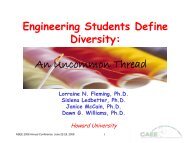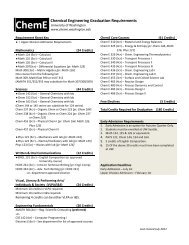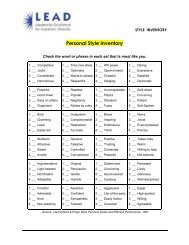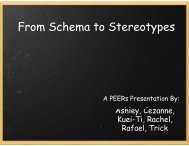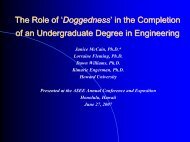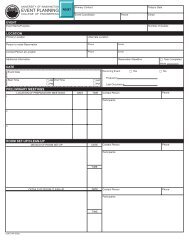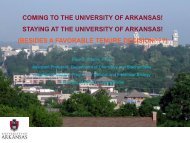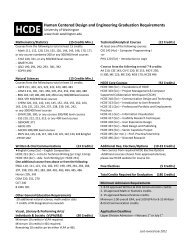Research Stars Light the Path - College of Engineering - University ...
Research Stars Light the Path - College of Engineering - University ...
Research Stars Light the Path - College of Engineering - University ...
- No tags were found...
You also want an ePaper? Increase the reach of your titles
YUMPU automatically turns print PDFs into web optimized ePapers that Google loves.
Message from <strong>the</strong> DeanIn contrast to gloomy news on <strong>the</strong>national and global fronts, we havegood news from UW <strong>Engineering</strong>.Foremost is <strong>the</strong> huge success <strong>of</strong>Campaign UW: Creating Futures.More than 10,000 friends helpedus raise $267 million, seven percentmore than our $250 million goal.New student and faculty endowmentscreated during <strong>the</strong> campaign willtransform <strong>the</strong> college’s research andeducational programs. A section <strong>of</strong>this issue celebrates your generoussupport and <strong>the</strong> future it creates.The feature story highlights <strong>the</strong>value <strong>of</strong> undergraduate research,with a focus on our efforts to createmore opportunities for women engineeringstudents.When I was in college in <strong>the</strong>early 1970s, women were activelydiscouraged from studying engineering.The emerging women’s movemen<strong>the</strong>lped dissipate that bias in<strong>the</strong> 1980s, and <strong>the</strong> percentage <strong>of</strong>women students rapidly shot upfrom <strong>the</strong> single digits to a little over20 percent. However, <strong>the</strong> percentagehas remained flat for <strong>the</strong> past twodecades, probably because manyyoung women still don’t resonatewith <strong>the</strong> image <strong>of</strong> <strong>the</strong> geek.A number <strong>of</strong> studies have shownthat women are much more drawnto fields that clearly benefit humanity.In recent years <strong>the</strong> pr<strong>of</strong>essionhas presented itself not just as aneconomic engine, but also a way tochange lives. This vision has been especiallytrue for disciplines workingat <strong>the</strong> interface <strong>of</strong> biology and engineering— bioengineering, chemicalengineering, and materials sciencehave attracted <strong>the</strong> highest percentage<strong>of</strong> females into engineering.When Pr<strong>of</strong>essor Mary Lidstromwas our associate dean for newinitiatives, she created a “biology forengineers” course that had greatsuccess demonstrating that bridge.We are committed to opening morepathways into engineering for youngwomen and to recruiting morewomen faculty. As you will read inthis issue, women engineers at <strong>the</strong>UW are doing exceptional researchand are outstanding role models.On ano<strong>the</strong>r front, I’m excitedabout two new federal grants highlightedon pages 3–4. A grant from<strong>the</strong> Department <strong>of</strong> Energy establishesa collaboration between UW andOregon State <strong>University</strong> on marinerenewable energy. Additionally,UW and Caltech will partner on aNational Science Foundation grantthat will build a research focus onmolecular programming.Molecular engineering is becominga major new thrust for us. Thisfield parallels <strong>the</strong> great advances at<strong>the</strong> end <strong>of</strong> <strong>the</strong> last century in designtools for mechanical and electricalsystems that can address many <strong>of</strong> <strong>the</strong>great challenges <strong>of</strong> our time, such ashealth, energy, and <strong>the</strong> environment.Two stories in <strong>the</strong> Innovator sectionreport some recent faculty work inmolecular engineering.Ano<strong>the</strong>r new focus area bridgesengineering and global health, <strong>the</strong>latter a growing strength at <strong>the</strong> UW.Bioengineering and Industrial <strong>Engineering</strong>have new global health grants,and you’ll hear a lot more about<strong>the</strong>se new initiatives in future issues.Mat<strong>the</strong>w O’DonnellFrank and Julie Jungers Dean<strong>of</strong> <strong>Engineering</strong>Taking ChargeThomas Calhoun is <strong>the</strong> new assistant dean for<strong>the</strong> <strong>Engineering</strong> Advising and Diversity Center.Previously he was executive director <strong>of</strong> GEAR UP,a statewide precollege program based at <strong>the</strong>UW. He has a long career in education on <strong>the</strong>East Coast and in Chicago. He recently earned hisPhD in educational leadership at <strong>the</strong> UW.Thomas CalhounCraig Benson became chair <strong>of</strong> Civil & Environmental<strong>Engineering</strong> on July 1. An expert ingeotechnical engineering, he comes to <strong>the</strong> UW from <strong>the</strong> <strong>University</strong><strong>of</strong> Wisconsin–Madison, where he chaired <strong>the</strong> geological engineeringprogram. Benson received his MS and PhD degrees in civilengineering from <strong>the</strong> <strong>University</strong> <strong>of</strong> Texas–Austin.Technical Communication did not need to look far for its new chair.Longtime faculty member Jan Spyridakis moved into <strong>the</strong> leadershiprole on August 1. She has won numerous awards for her researchon document design, usability, and online learning, and has beenhonored with <strong>the</strong> UW Distinguished Teaching Award. She earnedher BA through PhD degrees at <strong>the</strong> UW.Craig BensonJan SpyridakisIn Rarified CompanyBuddy Ratner, pr<strong>of</strong>essor<strong>of</strong> bioengineering andchemical engineering, willbe honored as one <strong>of</strong> <strong>the</strong>“One Hundred ChemicalEngineers <strong>of</strong> <strong>the</strong> ModernEra” by <strong>the</strong> American Institute<strong>of</strong> Chemical Engineersas part <strong>of</strong> its centennialcelebration. These 100 “guided <strong>the</strong>pr<strong>of</strong>ession into <strong>the</strong> new century” afterWorld War II. Ratner was selected in<strong>the</strong> New Frontiers category for workin engineered biomaterial surfaces tocontrol surface interaction and syn<strong>the</strong>sizedbiostable radio-frequency filmsand polymer scaffolds. The 100 wereselected from nearly 1000 nominations.2 TREND • Vol 58:2 • Autumn 2008



